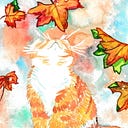Finnish Pagan Holidays: Mikonpäivä
In the old Finnish pagan wheel of the year, Mikonpäivä/Mikkelinpäivä the day of St.Michael was celebrated in 29th of September. In southern Savonia, this day was known as pässinpäivä the day of the ram.
Mikonpäivä started the winter season and was known as the gate to winter and the opposite of it was Hela the May festival which was a gate to the summer.
Finnish wheel of the year was based on agriculture and farming. Mikonpäivä was the time when people moved from outdoor works into indoor works. Mikonpäivä started the last harvest period.
After Mikonpäivä there was runtuviikko which was a free week for the servants. Runtuviikko included parties, dances, meetings and many couples got married during Runtuviiko.
Mikonpäivä was an important day for the shepherds because it was their last working day. To celebrate they lit bonfires to the hills.
There were all kinds of superstitions connected to Mikonpäivä. Livestock had to be brought inside before sunset. People were dressed up to their best and when they took animals inside they sang protection spells for the cattle. An arch was made of tree branches and put upon the gate that leads into stables. Horses had to walk underneath the arch for protection.
Sacrifices were made for the elves and spirits. Ancestors were thanked for protecting the cattle and keeping the livestock healthy. Sacrifices were bit different in different parts of the country. In some areas, drops of vodka and bread were left for the elves and in some areas, silver was given. In the morning, porridge was left for the house-elf into riihi (the building where rye was dried, riihi´s were common in Russia and Scandinavian countries).
In Eastern, Finland Mikonpäivä was the day of the ram and sheep and rams were sacrificed. Inner organs of the animal were buried underneath the spirit tree and the head was hanged into the branches. Rest of the meat was served as dinner. Other foods of pässinpäivä were potatoes, beer, cheese, porridge and cabbage. Why rams were sacrificed is unclear. It is possible that they were sacrificed to please the ancient fertility gods of the land of the ancestors.
In Karelia, Mikonpäivä was known as Pokrova and its symbol was the veil of Virgin Mary (pokrov is Russian and translates as safety, protection). In the pagan areas of Karelia, the last hay of the harvest were taken into the sacred groves. In the areas where religion was Russian Orthodox the hays were carried inside and put next to the images of saints where they were blessed and after that they were given for the cows to eat.
In the night of Pokrova horses wore warp during the night. It was believed that when they did that they would not feel cold during the winter months.
In Ingria when ladies took cattle inside the cattle shed they sang greeting songs for the earth spirit. It was believed that after Pokrovka it was forbidden to ”move the land” anymore because the land went to sleep. In Ingria, Pokrova was common hunting and fishing day.
If you enjoy reading my content, consider subscribing to my feed. Also, if you are not a Medium member and you would like to gain unlimited access to the platform, consider using my referral link right here to sign up. It’s $5 a month and you get unlimited access to my articles and many others like mine. Thanks
